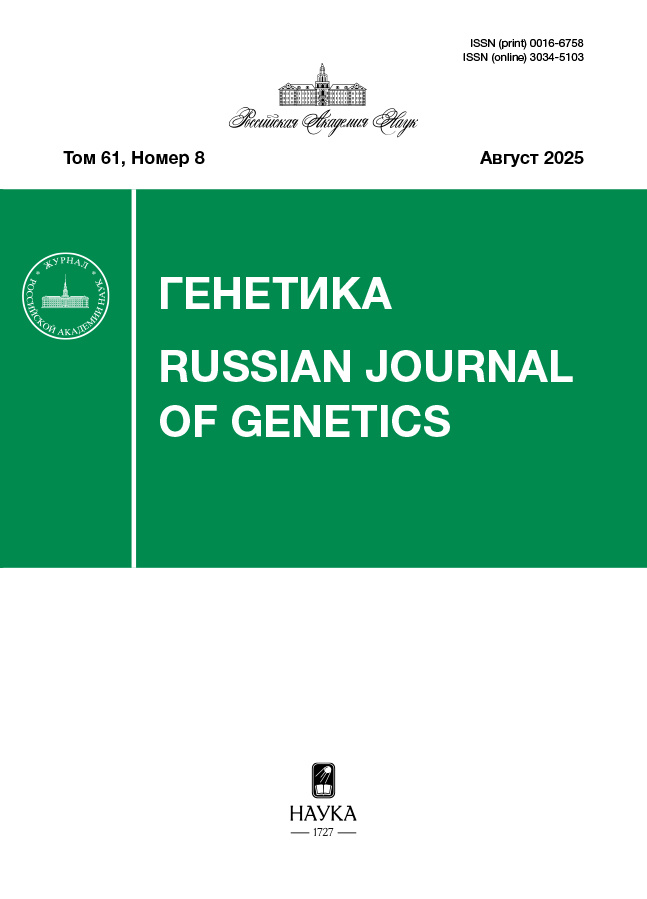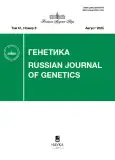ВОЗНИКНОВЕНИЕ СЛОЖНЫХ РЕЖИМОВ ДИНАМИКИ ЧИСЛЕННОСТИ ПОПУЛЯЦИЙ С ПРОСТОЙ ВОЗРАСТНОЙ СТРУКТУРОЙ В ХОДЕ ЕСТЕСТВЕННОГО ОТБОРА ОСОБЕЙ ПО ПЛОДОВИТОСТИ
- Авторы: Неверова Г.П.1, Фрисман Е.Я.2
-
Учреждения:
- Институт автоматики и процессов управления Дальневосточного отделения Российской академии наук
- Институт комплексного анализа региональных проблем Дальневосточного отделения Российской академии наук
- Выпуск: Том 61, № 8 (2025)
- Страницы: 100-120
- Раздел: МАТЕМАТИЧЕСКИЕ МОДЕЛИ И МЕТОДЫ
- URL: https://vestnik.nvsu.ru/0016-6758/article/view/693817
- DOI: https://doi.org/10.31857/S0016675825080091
- ID: 693817
Цитировать
Полный текст
Аннотация
В настоящей работе рассматривается модель эволюции двухвозрастной экологически лимитированной популяции, находящейся под действием естественного отбора, регулирующего плодовитость особей. Проведено аналитическое и численное исследование модели; определены параметрические области ее различного динамического поведения. Показано, что итоговый генетический состав популяции определяется взаимным расположением значений репродуктивности гетерозигот и гомозигот. При повышенной репродуктивности гетерозигот модель предсказывает устойчивый полиморфизм, при промежуточном доминировании – переходящий полиморфизм до мономорфизма или новой мутации. При пониженной репродуктивности гетерозигот наблюдается «ловушка бистабильности»: переход к одному из возможных мономорфных состояний в зависимости от начальных значений частот аллелей. Вместе с тем обнаружено, что в малом диапазоне значений параметров при пониженной репродуктивности гетерозигот в модели возникает мультистабильность, когда в зависимости от начальных значений частот аллелей наряду с «ловушкой бистабильности» может реализовываться устойчивый полиморфизм. Следовательно, вариация текущего состава популяции может привести к смене направления эволюции. При этом рост средней плодовитости особей дестабилизирует динамику численности возрастных групп, а характер возникающих колебаний определяется процессами экологического лимитирования.
Ключевые слова
Об авторах
Г. П. Неверова
Институт автоматики и процессов управления Дальневосточного отделения Российской академии наук
Автор, ответственный за переписку.
Email: galina.nev@gmail.com
Владивосток, 690041 Россия
Е. Я. Фрисман
Институт комплексного анализа региональных проблем Дальневосточного отделения Российской академии наук
Email: frisman@mail.ru
Биробиджан, 679016 Россия
Список литературы
- Itô Y., Iwasa Y. Evolution of litter size: I. Conceptual reexamination // Res. Population Ecology. 1981. V. 23. № 2. P. 344–359.
- Евсиков В.И., Потапов М.А. Эволюционная экология плодовитости животных: 50 лет изучения размножения как связующего звена поколений млекопитающих // Вавил. журн. генетики и селекции. 2011. Т. 15. № 1. С. 7–21.
- Wilsterman K., Bautista A.I., Butler C.E. et al. Evolution of litter size: proximate and ultimate mechanisms // Integrative and Comparative Biology. 2024. V. 64. № 6. P. 1643–1660. https://doi.org/10.1093/icb/icae052
- Rauw W.M., Luiting P., Beilharz R.G. et al. Selection for litter size and its consequences for the allocation of feed resources: A concept and its implications illustrated by mice selection experiments // Livestock Production Sci. 1999. V. 60. № 2–3. P. 329–342. https://doi.org/10.1016/S0301-6226(99)00104-
- Koivula M., Strandén I., Mäntysaari E.A. Genetic and phenotypic parameters of age at first mating, litter size and animal size in Finnish mink // Animal. 2010. V. 4. № 2. P. 183–188. https://doi.org/10.1017/S1751731109991170
- Vostry L., Milerski M., Schmidova J., Vostra-Vydro- va H. Genetic diversity and effect of inbree- ding on litter size of the Romanov sheep // Small Ruminant Res. 2018. V. 168. P. 25–31. https://doi.org/10.1016/j.smallrumres.2018.09.004
- Евсиков В.И., Назарова Г.Г., Рогов В.Г. Популяционная экология водяной полевки (Aricola terrestris L.) в Западной Сибири. Сообщение I. Репродуктивная способность самок, полиморфных по окраске шерстного покрова, на разных фазах динамики численности популяции // Сиб. экол. журн. 1999. Т. 1. С. 59–68.
- Angerbjörn A., Tannerfeldt M., Erlinge S. Predator-prey relationships: Arctic foxes and lemmings // J. Anim. Ecol. 1999. V. 68. P. 34–49. https://doi.org/10.1046/j.1365-2656.1999.00258.x
- Tannerfeldt M., Angerbjörn A. Fluctuating resources and the evolution of litter size in the arctic fox // Oikos. 1998. V. 83. P. 545–559. https://doi.org/10.2307/3546681
- Tannerfeldt M., Angerbjörn A. Life history strategies in a fluctuating environment: establishment and reproductive success in the arctic fox // Ecography. 1998. V. 19. P. 209–220. https://doi.org/10.1111/j.1600-0587.1996.tb01247.x
- Elmhagen B., Tannerfeldt M., Verucci P., Anger- björn A. The arctic fox (Alopex lagopus) – an opportunistic specialist // J. Zool. 2000. V. 251. P. 139–149. https://doi.org/10.1111/j.1469-7998.2000.tb00599.x
- Axenovich T.I., Zorkoltseva I.V., Akberdin I.R. et al. Inheritance of litter size at birth in farmed arctic fo-xes (Alopex lagopus, Canidae, Carnivora) // Heredity. 2007. V. 98. P. 99–105. https://doi.org/10.1038/sj.hdy.6800908
- Фрисман Е.Я., Жданова О.Л. Эволюционный переход к сложным режимам динамики численности двухвозрастной популяции // Генетика. 2009. Т. 45. № 9. С. 1277–1286.
- Неверова Г.П., Жданова О.Л., Фрисман Е.Я. Возникновение сложных режимов динамики численности в ходе эволюции структурированной лимитированной популяции // Генетика. 2020. V. 56. № 6. С. 714–725. https://doi.org/10.31857/S0016675820060065
- Neverova G.P., Zhdanova O.L., Frisman E.Ya. Effects of natural selection by fertility on the evolution of the dynamic modes of population number: Bistability and multistability // Nonlinear Dynamics. 2020. V. 101. № 1. P. 687–709. https://doi.org/10.1007/s11071-020-05745-w
- Неверова Г.П., Фрисман Е.Я. Режимы динамики популяции с неперекрывающимися поколениями с учетом генетической и стадийной структур // Компьютерные исследования и моделирование. 2020. Т. 12. № 5. С. 1165–1190. https://doi.org/10.20537/2076-7633-2020-12-5-1165-1190
- Neverova G.P., Zhdanova O.L., Frisman E.Y. Evolutionary dynamics of structured populations with density-dependent limitation of juvenile survival // Commun. in Nonlinear Science and Numerical Simulation. 2022. V. 109. № 106272. https://doi.org/10.1016/j.cnsns.2022.106272
- Дажо Р. Основы экологии. М.: Прогресс, 1975. 416 с.
- Свирежев Ю.М., Логофет Д.О. Устойчивость биологических сообществ. М.: Наука, 1978. 352 с.
- Кузнецов А.П., Седова Ю.В. Бифуркации трехмерных и четырехмерных отображений: Универсальные свойства // Изв. высших учебных заведений. Прикладная нелинейная динамика. 2012. Т. 20. № 5. С. 26–43.
- Кузнецов А.П., Савин А.В., Седова Ю.В., Тюрюкина Л.В. Бифуркации отображений. Саратов: ООО «Издательский центр Наука», 2012. 196 с.
- Курош А.Г. Курс высшей алгебры. Изд-во «Лань», 2013. 432 с.
Дополнительные файлы








